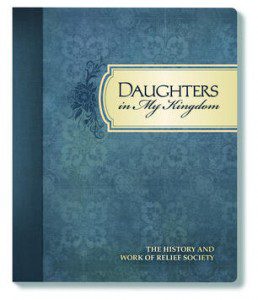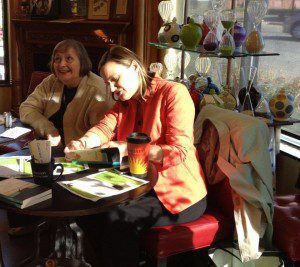
By Sarah Hogan
The history of the Relief Society is riveting stuff–seriously–and a book that recounts what Mormon women have accomplished should be both fascinating and inspiring. Daughters in My Kingdom duly provides some of each. Readers are cautioned in the introduction that, “This book is not a chronological history, nor is it an attempt to provide a comprehensive view of all that the Relief Society has accomplished. Instead, it provides a historical view of the grand scope of the work of the Relief Society” (xii).
Even so, the book is short on historical facts, touching only briefly on monumental episodes like Mormon women’s participation in national women’s suffrage and women’s role in medicine and healthcare in early Utah. The book contains many, many inspiring quotes and always specifies how the examples of LDS women of the past apply to us today.
Six chapters of the book tell the history of Relief Society in chronological order. This is the real meat of the book, and we get the great classic stories such as Joseph Smith organizing women after the order of the priesthood and women storing grain and selling it to the US government during World War I. There are also some lesser-known gems. We learn that visiting teachers used to visit not to minister to the sisters but to collect donations for the poor, including a tithe of one out of every ten jars of fruit that a woman was asked to donate from her home canning. We also discover that “Before leaving Nauvoo, a group of Latter-day Saints wrote… on the wall of the assembly hall in their abandoned temple: ‘The Lord has beheld our sacrifice: come after us’” (31). Although the Deseret silk making project is fairly well known, Zina D. H. Young’s nightmares about the silkworms she loathed make for compelling reading; she directed the project in a hands-on manner for 20 years despite her disgust.
This history is pretty much what one would expect of a chronicle of the Relief Society by the Relief Society for the Relief Society: That is, no one wants to tell the most uncomfortable stories of our own past. This is most evident in the time period just after Joseph Smith was killed. We are told:
“When the Saints left Nauvoo and during their journeyings, the Relief Society meetings were necessarily discontinued, though the sisters never lost sight of the institution, nor the promises made to them by President Joseph Smith…” (35-36).
The next paragraph skips ahead seven years to good works done by women in Utah, and then on to the eventual reorganization of Relief Society. There is no mention of the fact that Emma Smith, the first president of the Relief Society, failed to make the trip westward. There’s also no discussion of Brigham Young’s autocratic decision to disband the organization after Smith’s death, and just as abruptly order it revived again in 1854. Daughters does talk about polygamy, and not only its dissolution. As nothing gets more than a passing mention in this book, one can hardly fault it for not going into detail about polygamy, but certainly much was missed on this topic as well.
The additional five chapters of Daughters include topics such as visiting teaching, the value of women in New Testament times, and the essential role of women as “guardians of the hearth.” These chapters read essentially like any LDS lesson manual on the same topic. One exception is the chapter on “The Blessings of the Priesthood for All,” which won’t please anyone who wanted women to be ordained to the priesthood, but which handles the topic with some respect and consideration. The book deserves credit for taking the topic on in reference to women. While no mention is made of the historical practice of women laying on hands and healing in the early church, there is a story about a woman being inspired to know how to heal her son, and reference is made to women’s service in temples.
The book can be disjointed. The switch that it makes from a chronological to a topical organization part way through the book is disorienting and shortchanges the history itself.
Perhaps the greatest accomplishment of this book is its official endorsement of LDS women’s history. Mormons who know little about those who preceded them may be inspired by this book to search further and learn more. However, it is unfortunate that these readers will not find a greater quantity of solid historical information within this volume.
Sarah Hogan is an amateur enthusiast for LDS women’s history and the history of Mormons in the Boston area. She teaches the CTR class in her ward Primary.

